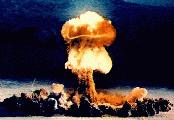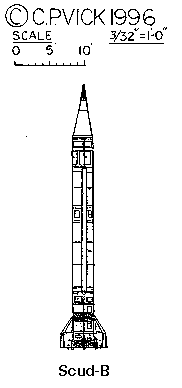






Syria was one of the Soviet Union's staunchest allies in the Middle East, and also received the Scud-B and Frog-7 systems in the early 1970s. In 1983, the Soviets delivered the SS-21 (120 km/480 kg), accurate to within 50 meters.
As of 1996 Syria was thought to have around 200 missiles, with 18 launchers for each of the three systems. (1) As of 1999 Syria was believed to have 200 Scud-B missiles and 60 longer-ranged Scud-C's. Syria is reported to have constructed a network of tunnels throughout the country to conceal its arsenal of ballistic missiles. As of June 1999 Syria was said to have built 5 tunnels concealing missiles and to be building another 9 tunnels.
Frequently appearing in the press are claims that Syria has developed CW warheads for its ballistic missiles. Citing anonymous U.S. or Israeli intelligence, these reports often state that Syria has developed a chemical warhead for the SS-21. (2) Other accounts claim that Damascus either obtained chemical warheads for the Scud and Frog systems from the Soviet Union or produced them indigenously with technology supplied by the Soviets. The Soviets denied categorically that they transferred chemical weapons outside of their borders. A detailed though unconfirmed account, claimed that Damascus had developed a 440 kg warhead for the Frog-7, of which half the weight was said to be a fill of the persistent nerve agent VX. The article further claimed that a 1,000 kg Scud warhead contained a 550 kg VX fill as well. These specifications are very similar to those of the Soviet chemical munitions displayed at Shikhany.
Rumors that Damascus might be trying to import the M-9 short-range ballistic missile from China have persisted. The M-9 is believed to be an advanced, mobile, solid-fuel missile with a 500 km range. In the summer of 1988, the deal was reportedly near completion, (3) although later articles concluded that U.S. pressure has halted the transaction. In May 1989, however, such a deal, with Saudi financial backing, was again reportedly closed. (4) Unnamed "reliable Israeli sources," reported in December 1989 that "Syria and China have signed a contract whereby China will sell 140 M-9 missiles to Syria for some $170 million." (5) The Chinese foreign ministry again denied these claims as "utterly groundless." (6) Assistant Secretary Clarke testified in July 1990 before the House Foreign Affairs Committee that, as far as he knew, the Chinese had neither sold nor transferred any missiles to the Middle East since the CSS-2 SSMs to Saudi Arabia, and he explicitly denied that the Chinese had sold any missiles to Syria. Furthermore, he said, the Bush administration had received a pledge from Beijing not to transfer or sell any missiles to the Middle East in the future. (7) There is no evident consensus among open sources specializing in military intelligence (e.g., Jane's Intelligence Review, Arms Control Today, American Sentinel, and others) on the status of the alleged M-9 order, and with time the preponderance of evidence suggested that in fact this transaction was not concluded.
1. W. Seth Carus, "Missiles in the Middle East," p. 7.
2. David B. Ottaway, "Israel Uneasy Over Word of Syria-Soviet Deal," The Washington Post, 25 Oct 88.
3. Newsweek, 27 June 88, p. 5.
4. "Syria reported to have acquired PRC ballistic missiles," Defense and Foreign Affairs Weekly, 5 June 89.
5. Jerusalem Post, 12 Dec 89, FBIS-CHI 12 Dec 89.
6. Xinhua, 11 Dec 89, FBIS-CHI 11 Dec 89.
7. Hearing before Subcommittee on Arms Control, International Security and Science, House Foreign Affairs Committee, 11 July 90.
